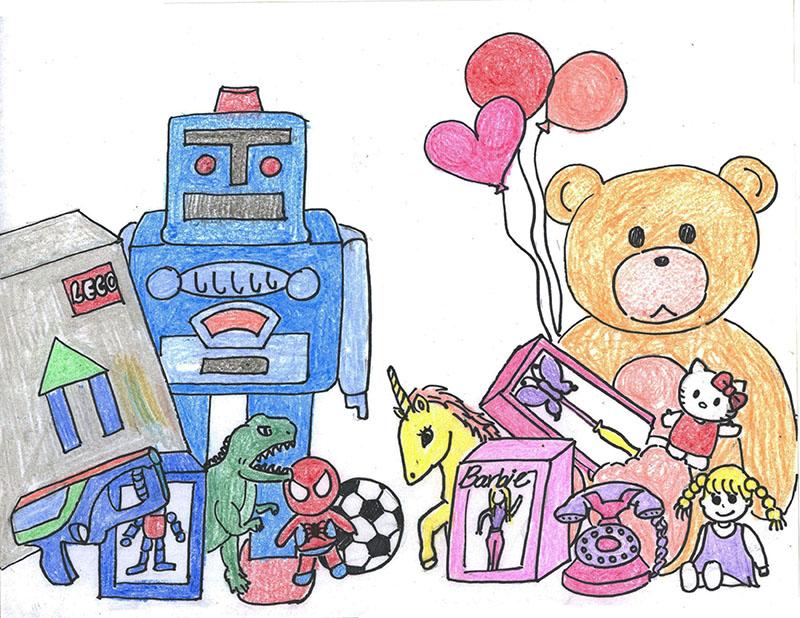Toying with gender norms
The toy aisles are blue on one side and pink on the other. Why?
The holidays are rolling in full-steam. In tow are ads, magazines and endless commercials advertising toys that make the children’s heads dance with plastic orange Nerf artillery and Elsa’s glittering ice palace instead of sugarplums. It doesn’t take a seasoned elf to notice the clash between boy’s and girl’s products. Camo-covered and fire-engine red trucks, trains and plastic weapons shout from the pages of the holiday magazines, featuring an all-boys club grinning with the tough, masculine toys. On the other side of the toy aisle, a Barbie-pink explosion of dolls, dolls and more dolls draws in a female audience of future princesses and fashionistas. One can’t help but wonder whether nature or nurture—or simply targeted advertising—is responsible for the dichotomy between genders.
“One of my nephews wanted an Easy-bake oven one Christmas, and there was a reaction from the parents. Of course, I bought it,” said principal Mrs. Eileen Manno.
Mrs. Manno’s experience with her nephew suggests that the distinction between the genders comes in part from society.
“Parents want everything for their kids,” Mrs. Manno said. “They want their kid to fit in to society and be happy, but sometimes there’s more harm in withholding something they want to play with.”
However, a child’s choice in plaything isn’t always dictated by a parent’s apprehension of societal judgment. Perhaps it’s the kids themselves calling the shots. Religion teacher Mrs. Rita King offers her insight as a grandparent and mother of three, a true veteran on the subject of children.
“I’ve had two daughters and a son, and I’ve never bought my daughters a GI Joe, or my son a Barbie,” she said. “But my son would choose to play with the girls’ kitchen set or the girls played with his tools. He would wait for his sisters to invite him to a tea party, and they would pour him a drink.”
Tea parties may be invitation-only for the boys, but from Mrs. King’s observation, there are some games girls choose not to join in on.
“I watch my three grandsons play, and it’s pandemonium,” she said. “My son would want to roughhouse with the girls, and he would dive bomb from the back of the couch and land on them. No one’s teaching them to do that.”
So who is?
“I’ve never seen my daughters make a gun out of a paper towel roll, the play of the boys is much more aggressive,” said King. “It just happens biologically,” she said.
Ms. Kelli Wosick, girls’ cross country and track coach, is studying for a Masters degree in human sexuality studies. Her psychological studies suggest that gender is more shaped by outside forces than previously known.
“The biggest influence [on young people] is the media,” said Ms. Wosick. “It saturates us with so many expectations, but you can never fit expectations. Kids don’t know how to process all that information.”
The deluge of information beating down upon the minds of our generation is enough to make anyone’s head spin. Depending on who’s pulling the strings, it is easy for kids to get tangled up in misconceptions about who they are and who society tells them to be.
“Society tells you that everything has to be in a perfect box, but in reality there are so many different ways to express yourself,” said Ms. Wosick. “When you look around, there aren’t that many people that actually fit expectations. We’re all trying to fit in this bubble that we think exists.”
It is impossible for anyone to fit into society’s supposed norms when the norms themselves are under the biggest evolution of our time. Technology improves at the speed of light, and children being born into the world will update just like the latest iPhone.
“We have some fathers who are primary home providers and moms are out working, only in the last fifteen years,” said Mrs. Manno. “There are men who cook dinner because they get home from work first, or throw in a load of laundry. I can’t imagine my dad doing either one forty years ago when women only worked in the home.”
As the times change, it would stand to reason the world around us would have some disconnect as it struggles to keep up. There exists a changing understanding of gender, especially the heightened awareness of the struggles transgender people face from simple tasks such as using a public restroom.
“If people act or dress apart from the expected gender, it raises controversy,” said Ms. Wosick. “What is normal? We derive our normal from the people in power, and that shapes how we act and view society. We are constantly suppressing parts of ourselves to fit in the expected box assigned to us.”
Mrs. Manno offers an explanation for the social turmoil enveloping us all.
“People become frightened by change,” said Mrs. Manno.
Somewhere colorfully wrapped within our genes, hearts, and souls are the keys that make us human. Pink and blue is an oversimplification. Boy or girl, people are multicolored in interests, preferences and ways of expressing their humanness.
“We’re all weird, we just don’t accept that we are,” said Ms. Wosick.
So why do toy companies reject that from the moment we’re born?
Your donation will support the student journalists of Saint Viator High School. Your contribution will allow us to purchase equipment and cover our annual website hosting costs.








